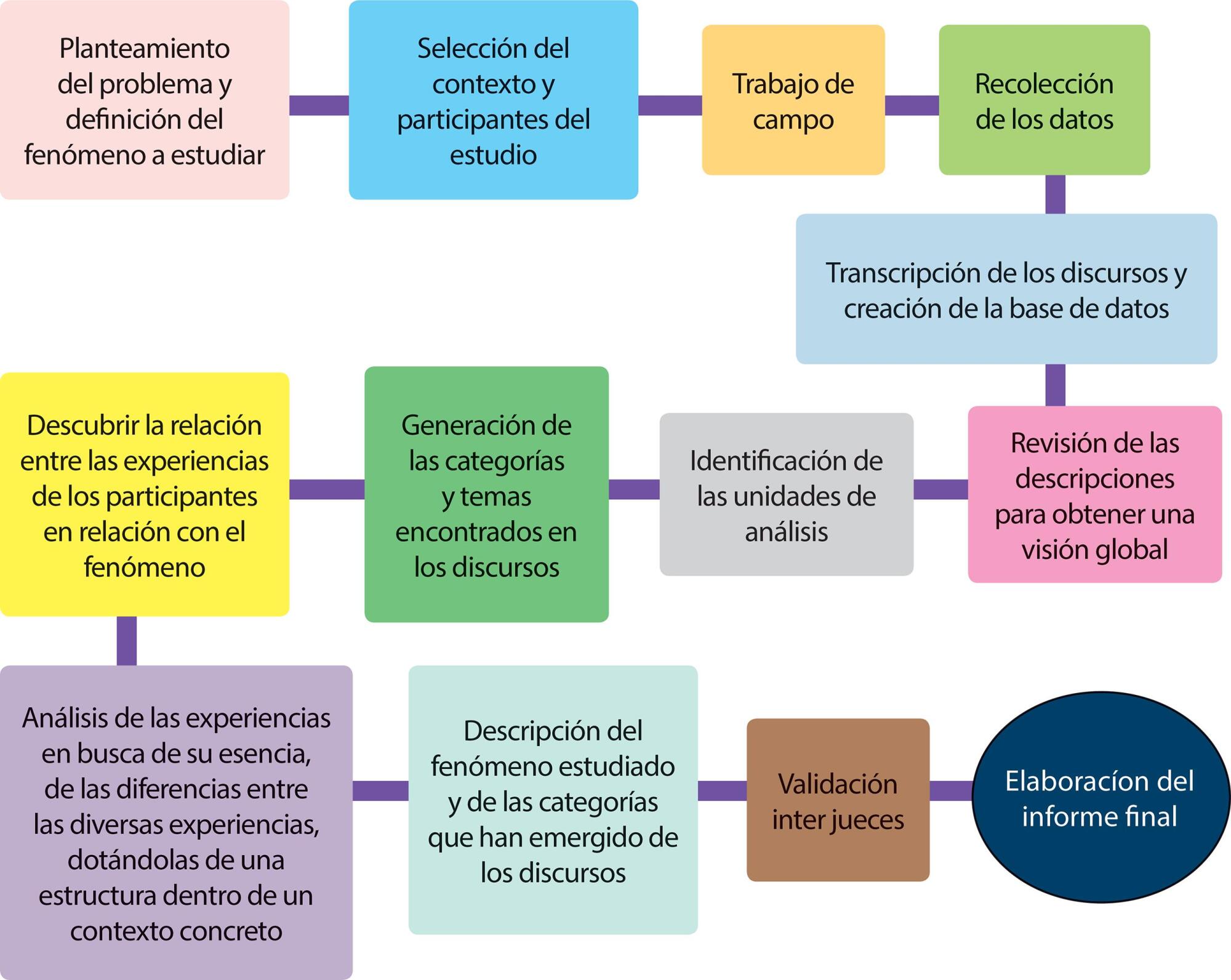-
REFLECTION01-01-2017
Nursing supervision for care comprehensiveness
Revista Brasileira de Enfermagem. 2017;70(5):1106-1111
Abstract
REFLECTIONNursing supervision for care comprehensiveness
Revista Brasileira de Enfermagem. 2017;70(5):1106-1111
DOI 10.1590/0034-7167-2016-0491
Views0See moreABSTRACT
Objective:
To reflect on nursing supervision as a management tool for care comprehensiveness by nurses, considering its potential and limits in the current scenario.
Method:
A reflective study based on discourse about nursing supervision, presenting theoretical and practical concepts and approaches.
Results:
Limits on the exercise of supervision are related to the organization of healthcare services based on the functional and clinical model of care, in addition to possible gaps in the nurse training process and work overload. Regarding the potential, researchers emphasize that supervision is a tool for coordinating care and management actions, which may favor care comprehensiveness, and stimulate positive attitudes toward cooperation and contribution within teams, co-responsibility, and educational development at work.
Final considerations:
Nursing supervision may help enhance care comprehensiveness by implying continuous reflection on including the dynamics of the healthcare work process and user needs in care networks.
-
REVIEW01-01-2017
Nursing knowledge and practices regarding subcutaneous fluid administration
Revista Brasileira de Enfermagem. 2017;70(5):1096-1105
Abstract
REVIEWNursing knowledge and practices regarding subcutaneous fluid administration
Revista Brasileira de Enfermagem. 2017;70(5):1096-1105
DOI 10.1590/0034-7167-2016-0424
Views0See moreABSTRACT
Objective:
To describe the evidence in the literature regarding the knowledge and practices of the nursing team about subcutaneous administration of drugs and fluids in adults.
Method:
Integrative review of the literature using the descriptors “nursing”, “hypodermoclysis”, “drug administration routes”, “adult health,” and “knowledge,” in English, Spanish, and Portuguese, with no publication deadline. Of the 569 articles found, eight made up the sample.
Results:
A predominance of international journals (75%) with more than five years of publication (62.5%). The analysis of the methodological characteristics showed a predominance of literature reviews (25%), quantitative studies (62.5%), cross-sectional studies (50%), and non-experimental studies (50%).
Conclusion:
Although it is an old technique with proven efficacy, hypodermoclysis is still little used, a puzzling fact due to its advantages and indications for any age.
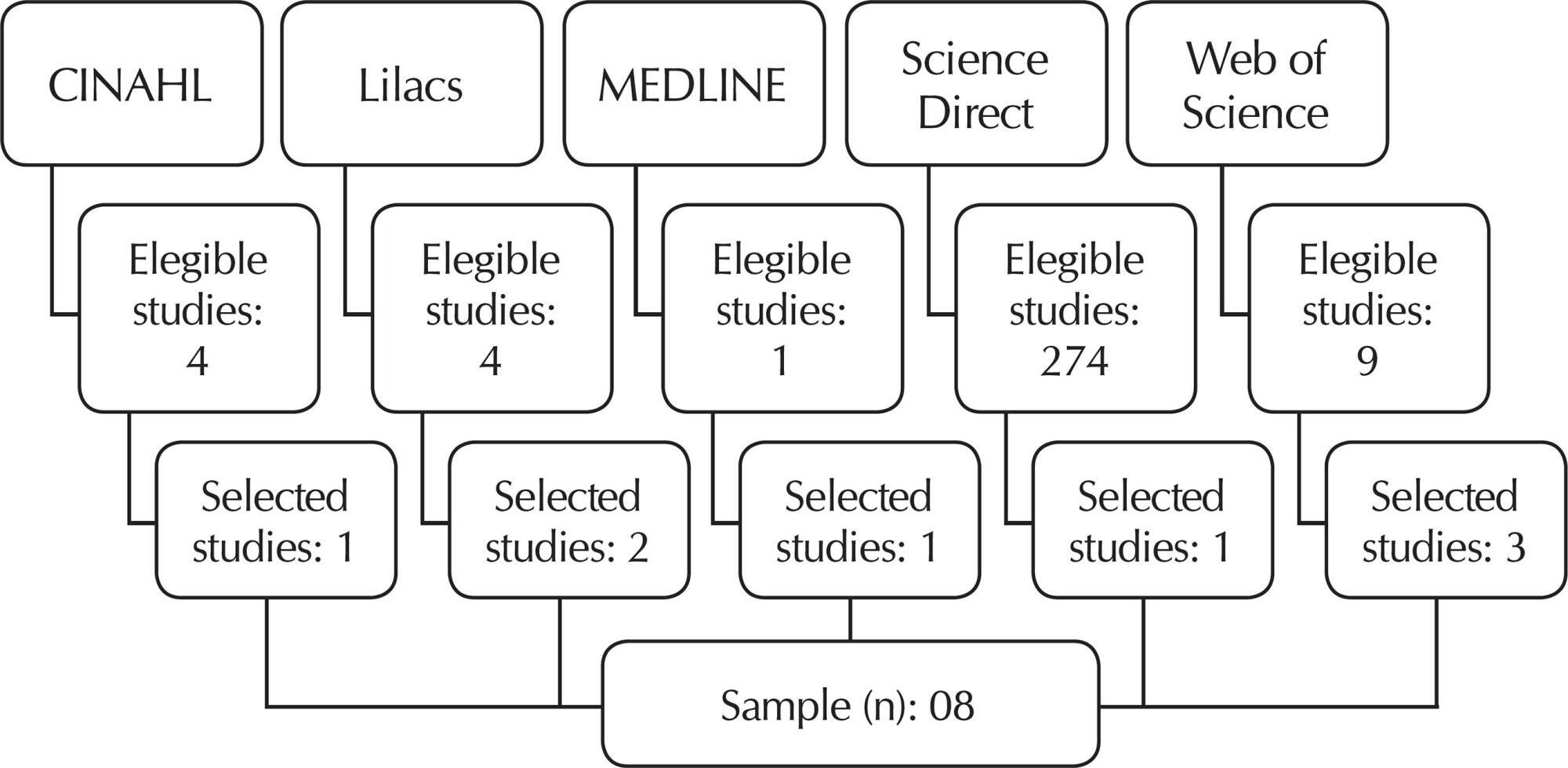
-
REVIEW01-01-2017
Communicating bad news: an integrative review of the nursing literature
Revista Brasileira de Enfermagem. 2017;70(5):1089-1095
Abstract
REVIEWCommunicating bad news: an integrative review of the nursing literature
Revista Brasileira de Enfermagem. 2017;70(5):1089-1095
DOI 10.1590/0034-7167-2016-0143
Views0See moreABSTRACT
Objectives:
describe how the process of breaking bad news is established and identify how nurses approach the task of giving bad news.
Method:
integrative review of the literature for articles in Portuguese and English published between 1993-2014, in the databases: Bireme, PubMed, Scopus, Web of Science, CINAHL and Embase. Nine articles were included using the selection flow chart. A digital form was completed for each article according to the Consolidated Criteria for Reporting Qualitative Research checklist and the level of scientific evidence was determined.
Results:
Of the 99 articles in identified, nine were included after applying the selection flowchart.
Discussion:
breaking bad news is frequent in the area of oncology and palliative care, with a strong cultural influence on the autonomy of nurses in this process.
Conclusion:
the approach and skills of the nurse during this task influences the patient’s reaction to the message. The theme is scarce in the literature and merits further investigation.
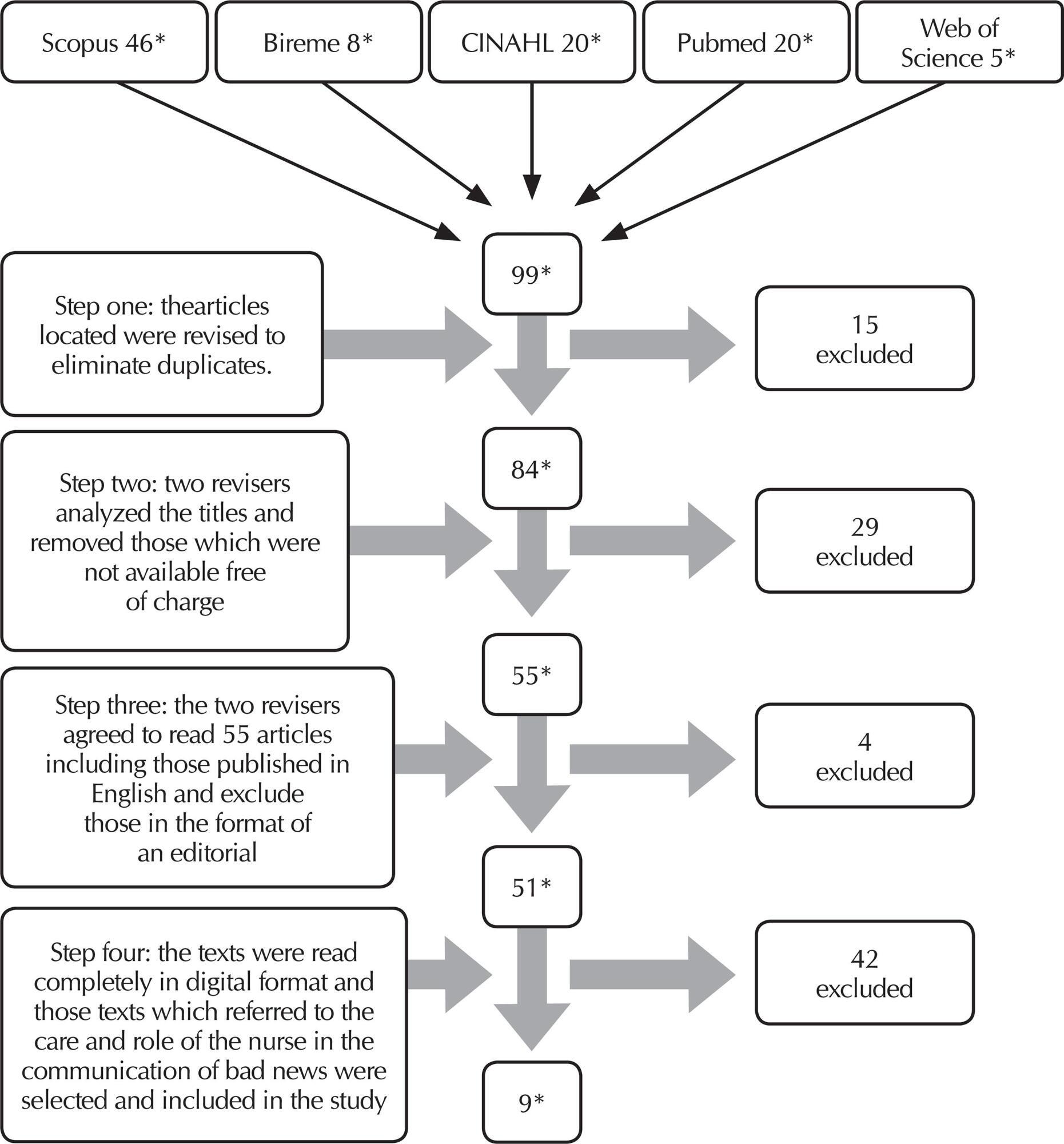
-
REVIEW01-01-2017
Patient safety and nursing: interface with stress and Burnout Syndrome
Revista Brasileira de Enfermagem. 2017;70(5):1083-1088
Abstract
REVIEWPatient safety and nursing: interface with stress and Burnout Syndrome
Revista Brasileira de Enfermagem. 2017;70(5):1083-1088
DOI 10.1590/0034-7167-2016-0194
Views0See moreABSTRACT
Objective:
To analyze studies on stress, Burnout Syndrome, and patient safety in the scope of nursing care in the hospital environment.
Method:
This was an integrative literature review. Data collection was performed in February 2016 in the following databases: Medical Literature Analysis and Retrieval System Online – PubMed/MEDLINE, Latin American and Caribbean Literature in Health Sciences – LILACS.
Results:
Ten scientific productions were selected, which listed that factors contributing to stress and Burnout Syndrome of nursing professionals are the work environment as a source of stress, and excessive workload as a source of failures.
Conclusion:
The analysis found that the stress and Burnout Syndrome experienced by these professionals lead to greater vulnerability and development of unsafe care, and factors such as lack of organizational support can contribute to prevent these failures.

-
RESEARCH01-01-2017
Associative organization of nursing: struggles for the social recognition of the profession (1943-1946)
Revista Brasileira de Enfermagem. 2017;70(5):1075-1082
Abstract
RESEARCHAssociative organization of nursing: struggles for the social recognition of the profession (1943-1946)
Revista Brasileira de Enfermagem. 2017;70(5):1075-1082
DOI 10.1590/0034-7167-2017-0186
Views0See moreABSTRACT
Objective:
To describe the circumstances that determine the creation of the Brazilian Association of Graduate Nurses of the Federal District Section and analyze its implications for the reorganization of the field of nursing.
Method:
Qualitative, socio-historical, documentary study. The analysis generated the following category: Creation of a new group to guarantee unity: Brazilian Association of Graduate Nurses in the Federal District Section.
Results:
The economic crisis resulting from the Second World War, the creation of the Paulista Association of Graduate Nurses and the increase in the number of Schools of Nursing in the country were decisive for the Brazilian Association of Graduate Nurses to reformulate its statute as to guarantee its unit.
Final considerations:
The creation of the Federal District Section consisted of one of the strategies of the Association to reorganize the field of nursing, in order to ensure the recognition of the profession by the society.
-
RESEARCH01-01-2017
University management: contributions for nurses who are faculty members and managers
Revista Brasileira de Enfermagem. 2017;70(5):1069-1074
Abstract
RESEARCHUniversity management: contributions for nurses who are faculty members and managers
Revista Brasileira de Enfermagem. 2017;70(5):1069-1074
DOI 10.1590/0034-7167-2017-0068
Views0See moreABSTRACT
Objective:
To comprehend how university management contributes on the performance of nurses who are professors and managers in a public university.
Method:
Qualitative research anchored on the Grounded Theory. The setting to collect the data was a public university in south Brazil and it happened between May and September of 2016. A total of 19 nurses took part in the study, all of them also faculty members and managers that were divided in two sample groups.
Results:
Two subcategories were created: the comprehension that university management improves the faculty performance; obtaining a wider view of the university.
Final considerations:
The contributions of university management for faculty nurses who are managers are mainly on the personal and professional satisfaction through the production and dissemination of knowledge, reflecting positively on the refinement of the teaching competences to train Nurses with knowledge, technical skills and cognitive abilities to answer society’s needs.
-
RESEARCH01-01-2017
Profile of Brazilian workers victims of occupational accidents with biological fluids
Revista Brasileira de Enfermagem. 2017;70(5):1061-1068
Abstract
RESEARCHProfile of Brazilian workers victims of occupational accidents with biological fluids
Revista Brasileira de Enfermagem. 2017;70(5):1061-1068
DOI 10.1590/0034-7167-2016-0482
Views0ABSTRACT
Objective:
To characterize the Brazilian workers victims of occupational accidents with biological fluids.
Method:
Epidemiological and descriptive research, in which 284,877 notifications of the Notifiable Diseases Information System were analyzed between 2007 and 2014. We used Stata 13 for data analysis.
Results:
The highest incidence density occurred in females with 0.8 cases per 1,000 workers/year (n = 222,042, 77.9%); in the age group of 20 to 24 years old, with 0.6 cases per 1,000 workers/year (n = 64,221, 23.3%); with some high school and some college, with 0.6 cases per 1,000 workers/year (n = 141,275, 49.6%). We found that these accidents occurred among 23 occupational subgroups. For the most part, the workers had an employment relationship and had issued the Occupational Accident Notification.
Conclusion:
It is necessary to rethink the measures of orientation to workers regarding the risks and relative prophylaxis for these accidents, with the aim of reducing them.
Keywords:Categories of WorkersExposure to Biological AgentsInformation SystemsOccupational AccidentsOccupational Health NursingSee more -
RESEARCH01-01-2017
Developing skills learning in obstetric nursing: approaches between theory and practice
Revista Brasileira de Enfermagem. 2017;70(5):1054-1060
Abstract
RESEARCHDeveloping skills learning in obstetric nursing: approaches between theory and practice
Revista Brasileira de Enfermagem. 2017;70(5):1054-1060
DOI 10.1590/0034-7167-2016-0665
Views0See moreABSTRACT
Objective:
To analyze the development of professional skills in an obstetric nursing graduate course.
Method:
Qualitative research, applying semi-structured interviews with 11 students in the obstetric nursing specialization at the State University of Ceará. Data was submitted to thematic review.
Results:
According to the subjects, the course offers the development of skills to strengthen and expand the range of activities in obstetric nursing. Despite relying on previous knowledge and experience acquired by the students, there is a gap between the content taught and internship practice, presented as challenges and difficulties faced by the students. The findings suggest a need for curricular revision, incorporating active teaching-learning methodologies, to overcome the disjunction between theory and practice.
Final considerations:
Students are part of a corpus that is potentially implicated in the construction and transformation of thoughts and values set forth by educational and health institutions, and it is necessary to make changes in political and social organizations, with a focus on providing comprehensive and egalitarian care to the population.
-
REVIEW11-22-2024
Telenursing contributions in Primary Health Care in the COVID-19 pandemic context: an integrative review
Revista Brasileira de Enfermagem. 2024;77(5):e20240093
Abstract
REVIEWTelenursing contributions in Primary Health Care in the COVID-19 pandemic context: an integrative review
Revista Brasileira de Enfermagem. 2024;77(5):e20240093
DOI 10.1590/0034-7167-2024-0093
Views1See moreABSTRACT
Objective:
to identify telenursing contributions in Primary Health Care during the COVID-19 pandemic.
Methods:
an integrative literature review, conducted between January and August 2022 in the PubMed, CINAHL, LILACS, BDENF, Scopus, WoS, EMBASE and SciELO databases. A total of 493 studies was found, 62 were read in full, and of these, 16 were selected. For analysis, a dynamic reading of the studies and synthesis of the main results were carried out.
Results:
the main results highlighted telenursing practice as a challenge for professionals and the population. Among the contributions and positive points and aspects that require improvement, practice showed promise when considered in a post-pandemic scenario.
Final considerations:
through telenursing, the population’s access to Primary Health Care was guaranteed in the face of the COVID-19 pandemic. However, a critical look at current technological advances in healthcare is necessary.
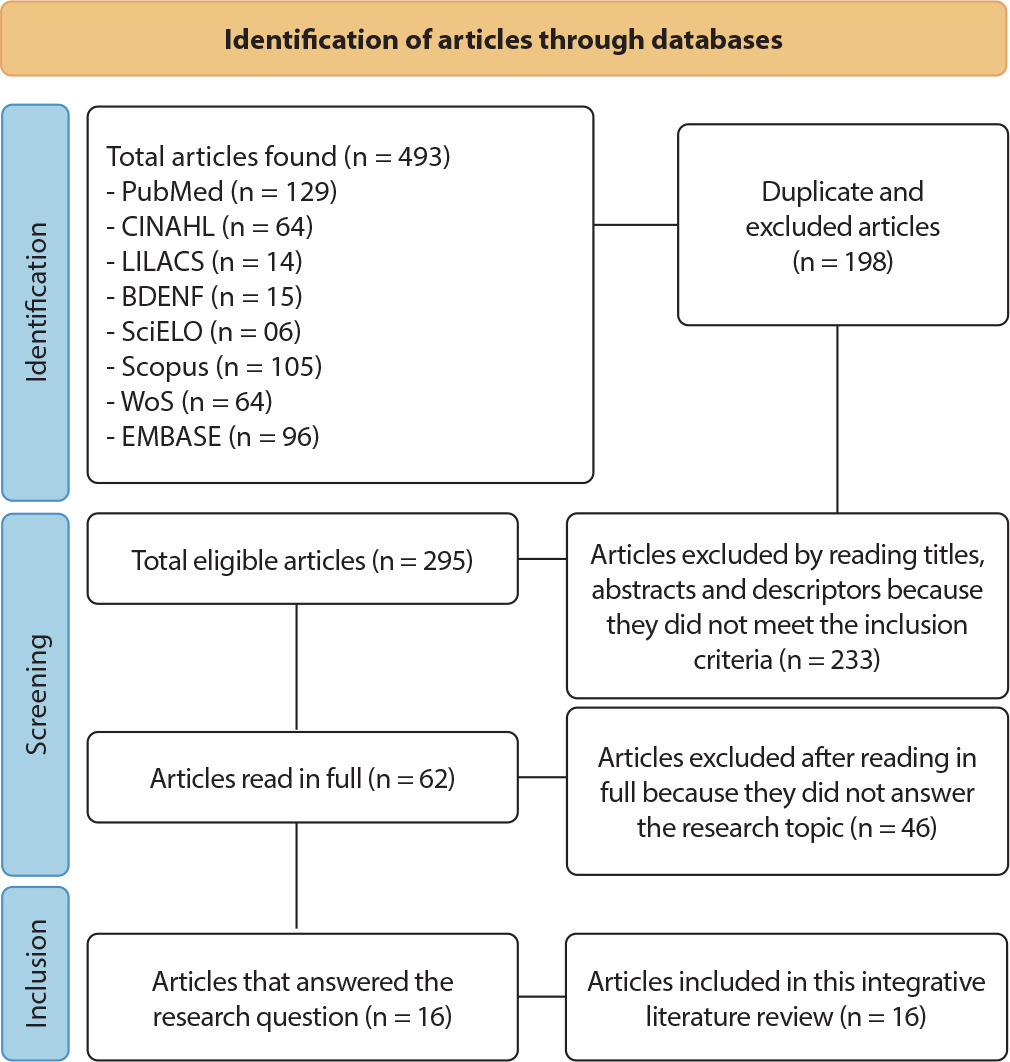
-
ORIGINAL ARTICLE12-16-2024
The nursing practice environment and hospital sociotechnical complexity: a mixed-methods study
Revista Brasileira de Enfermagem. 2024;77(6):e20230315
Abstract
ORIGINAL ARTICLEThe nursing practice environment and hospital sociotechnical complexity: a mixed-methods study
Revista Brasileira de Enfermagem. 2024;77(6):e20230315
DOI 10.1590/0034-7167-2023-0315
Views1See moreABSTRACT
Objectives:
to analyze the relationship between the nursing practice environment and hospital sociotechnical complexity as perceived by nurses.
Methods:
a sequential explanatory mixed-methods study was conducted in a hospital in southern Brazil. The Brazilian version of the Practice Environment Scale-Nursing Work Index and the Complexity Characterization Questionnaire were administered to 132 nurses. Subsequently, semi-structured interviews were conducted with 18 participants, and the data were subjected to thematic analysis. Data integration was achieved through a connection approach.
Results:
the nursing practice environment was found to be favorable, except in the subscale concerning Staffing and Resource Adequacy, where complexity was present in the activities. The three emerging categories explained human and technical aspects related to complexity in the practice environment, quality of care, and patient safety. Unexpected variability was inversely correlated with the practice environment.
Conclusions:
the study results indicate a relationship between these constructs, with implications for the quality and the safety of care.
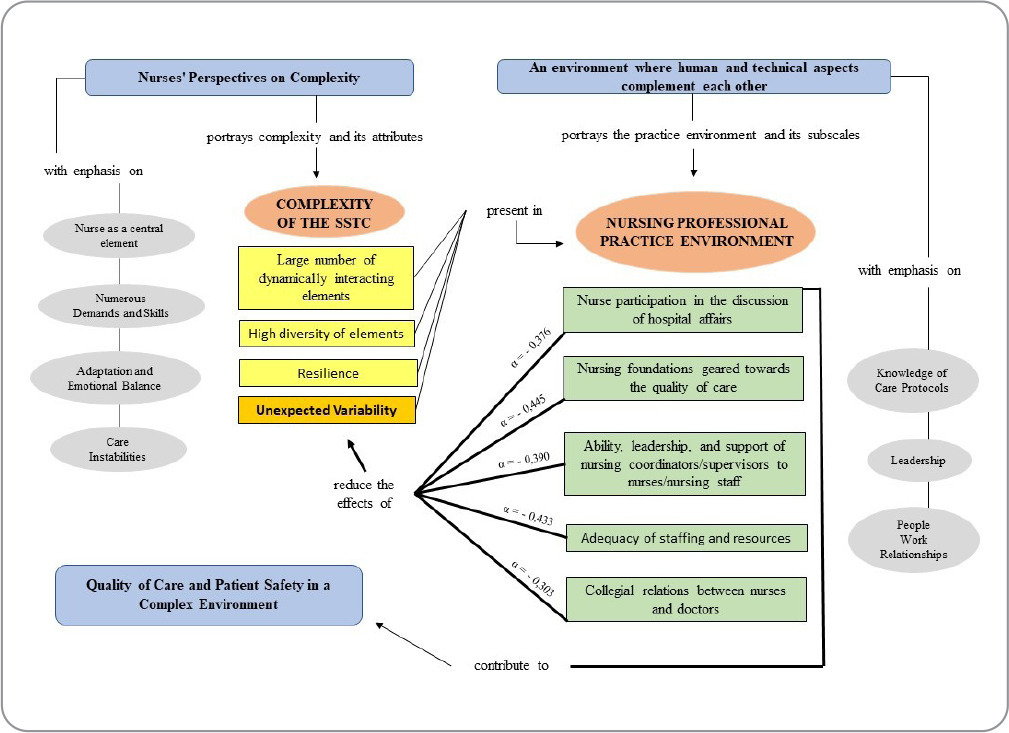
-
ORIGINAL ARTICLE01-13-2024
Nurses’ perspectives on the use of telemonitoring in the management of people with diabetes and hypertension
Revista Brasileira de Enfermagem. 2024;77(6):e20230481
Abstract
ORIGINAL ARTICLENurses’ perspectives on the use of telemonitoring in the management of people with diabetes and hypertension
Revista Brasileira de Enfermagem. 2024;77(6):e20230481
DOI 10.1590/0034-7167-2023-0481
Views1See moreABSTRACT
Objectives:
to understand the perspective of nurses on the use of telemonitoring in the management of people with type 2 diabetes mellitus and arterial hypertension in primary care.
Methods:
this qualitative research involved sixteen nurses from eight municipalities in Paraná. Data were collected between November 2022 and January 2023 through inperson or remote interviews, which were audio-recorded and subjected to content analysis.
Results:
according to the nurses, telemonitoring enhances users’ knowledge about these conditions, communication and connection with the team, and productivity. However, the lack of electronic resources and equipment, high staff turnover, low user adherence, and the limited availability of professional time present significant challenges.
Final Considerations:
the effective implementation and operation of telemonitoring in the management of people with diabetes and hypertension involve both potential benefits and barriers. It is essential to have the availability of human and technological resources, managerial support, and the commitment of professionals and users.
-
REVIEW12-16-2024
Recommendations for guidelines for promoting mental health in the workplace: an umbrella review
Revista Brasileira de Enfermagem. 2024;77(6):e20240086
Abstract
REVIEWRecommendations for guidelines for promoting mental health in the workplace: an umbrella review
Revista Brasileira de Enfermagem. 2024;77(6):e20240086
DOI 10.1590/0034-7167-2024-0086
Views1See moreABSTRACT
Objectives:
to summarize the recommendations of guidelines for promoting mental health in the workplace.
Methods:
an umbrella review, according to Joanna Briggs Institute and Preferred Reporting Items for Systematic reviews and Meta-Analyses methodological assumptions. Data collection was carried out in January 2021 and updated in July 2023 in the American Psychological Association, Cochrane Library, EMBASE, National Library of Medicine, and Scopus databases. Systematic reviews that assessed guidelines with recommendations for mental health care for workers were included. PROSPERO registration CRD42023461845.
Results:
four systematic reviews published between 2015 and 2018 were identified. The abstracts highlighted actions that facilitate and inhibit the recommendations as well as three categories of intervention: primary prevention – worker protection; secondary prevention – promoting workers’ mental health; and tertiary prevention – supporting, monitoring and rehabilitating workers upon returning to work.
Conclusions:
the interventions are based on prevention, promotion and early recognition, support and rehabilitation of mental health problems.
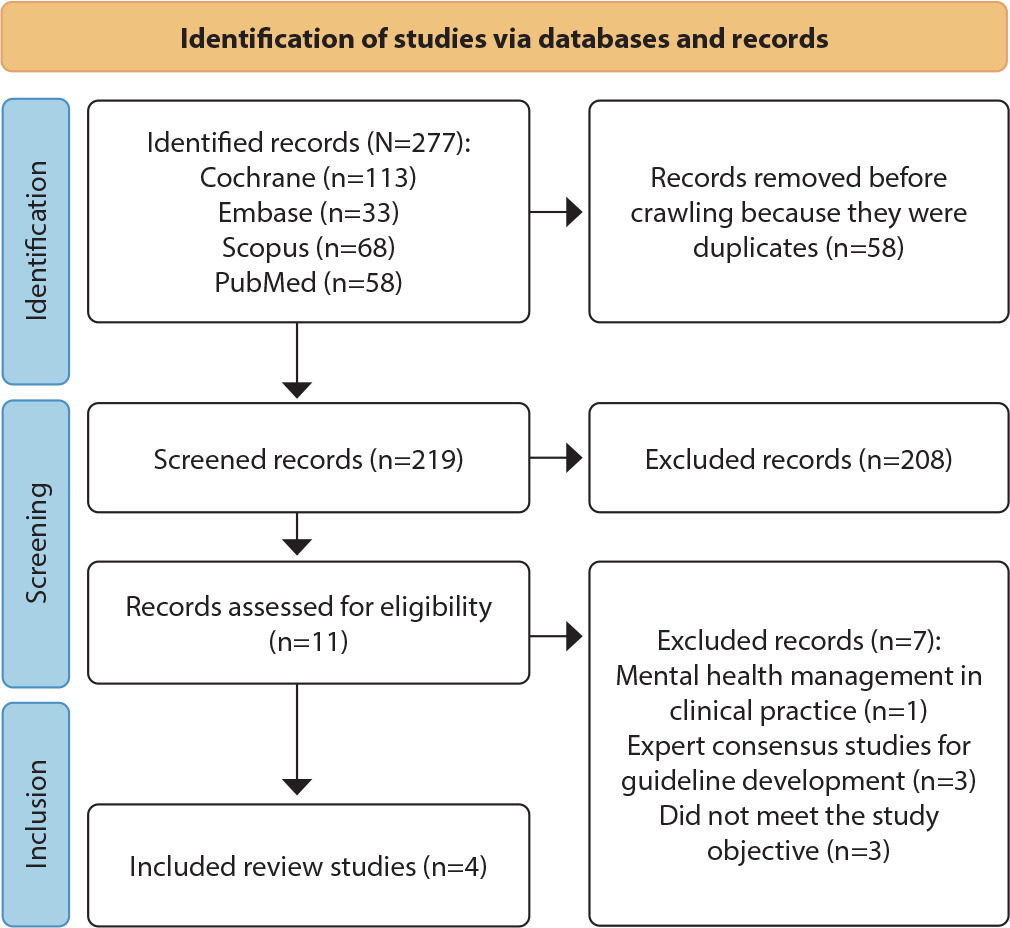
-
EDITORIAL03-08-2024
Nursing as a player in tackling vaccine hesitancy and refusal
Revista Brasileira de Enfermagem. 2024;77:e77suppl101
Abstract
EDITORIALNursing as a player in tackling vaccine hesitancy and refusal
Revista Brasileira de Enfermagem. 2024;77:e77suppl101
DOI 10.1590/0034-7167.202477suppl101
Views1Since the 1970s, the Brazilian Ministry of Health established the Brazilian National Immunization Program (PNI – Programa Nacional de Imunização), which preceded the Brazilian Health System and which was incorporated and strengthened due to the decentralized model to municipalities, but under single command at central level. Its objective was and still is to coordinate vaccination […]See more -
ORIGINAL ARTICLE12-21-2020
Development of an appearance validity instrument for educational technology in health
Revista Brasileira de Enfermagem. 2020;73:e20190559
Abstract
ORIGINAL ARTICLEDevelopment of an appearance validity instrument for educational technology in health
Revista Brasileira de Enfermagem. 2020;73:e20190559
DOI 10.1590/0034-7167-2019-0559
Views1ABSTRACT
Objectives:
to develop and evaluate the convergence of the instrument for the appearance validity of educational technologies in health.
Methods:
methodological study conducted in two steps. In step 1, the instrument items were developed, with subsequent content validity by nine specialists in the development of educational technologies in health. In step 2, the convergent validity between another instrument and the appearance instrument was performed. Correlation results above r> 0.3 and p <0.05 were considered as plausible convergent validity.
Results:
the ten items of the initial version of the appearance instrument were submitted to content validity that resulted in a final version with 12 items (Content Validity Index = 0.93). The correlation indexes were strong with the objective and appearance domains; moderate with motivation, organization and total; and weak with writing style.
Conclusions:
the appearance instrument demonstrated content validity and convergent validity, in addition to a strong correlation with the other instrument.
Keywords:Educational TechnologyHealth EducationMethodological Research in NursingTechnological DevelopmentValidation StudiesSee more -
Real and illusory perceptions of patients in induced coma
Revista Brasileira de Enfermagem. 2019;72(3):818-824
Abstract
Real and illusory perceptions of patients in induced coma
Revista Brasileira de Enfermagem. 2019;72(3):818-824
DOI 10.1590/0034-7167-2017-0906
Views1See moreABSTRACT
Objective:
To identify, in the scientific literature, real and illusory perceptions of adult patients in induced coma.
Methods:
This is an integrative review of 15 primary studies from the Medline, Web of Science, LILACS, CINAHL and SCOPUS databases.
Results:
The main memories reported after induced coma were thirst, cold, and pain. In some studies, patients reported they were unable to tell whether they were awake or dreaming, whether it was real or unreal. Satisfactory memories were reported by patients related to the care received and the use of bedside journals.
Conclusion:
Evidence showed a number of studies aiming to identify delirium, but without a focus on analyzing real or illusory perceptions of patients after induced coma. Thus, this integrative review identified scientific evidence of memories related to perceptions of sedated patients in the intensive care unit.
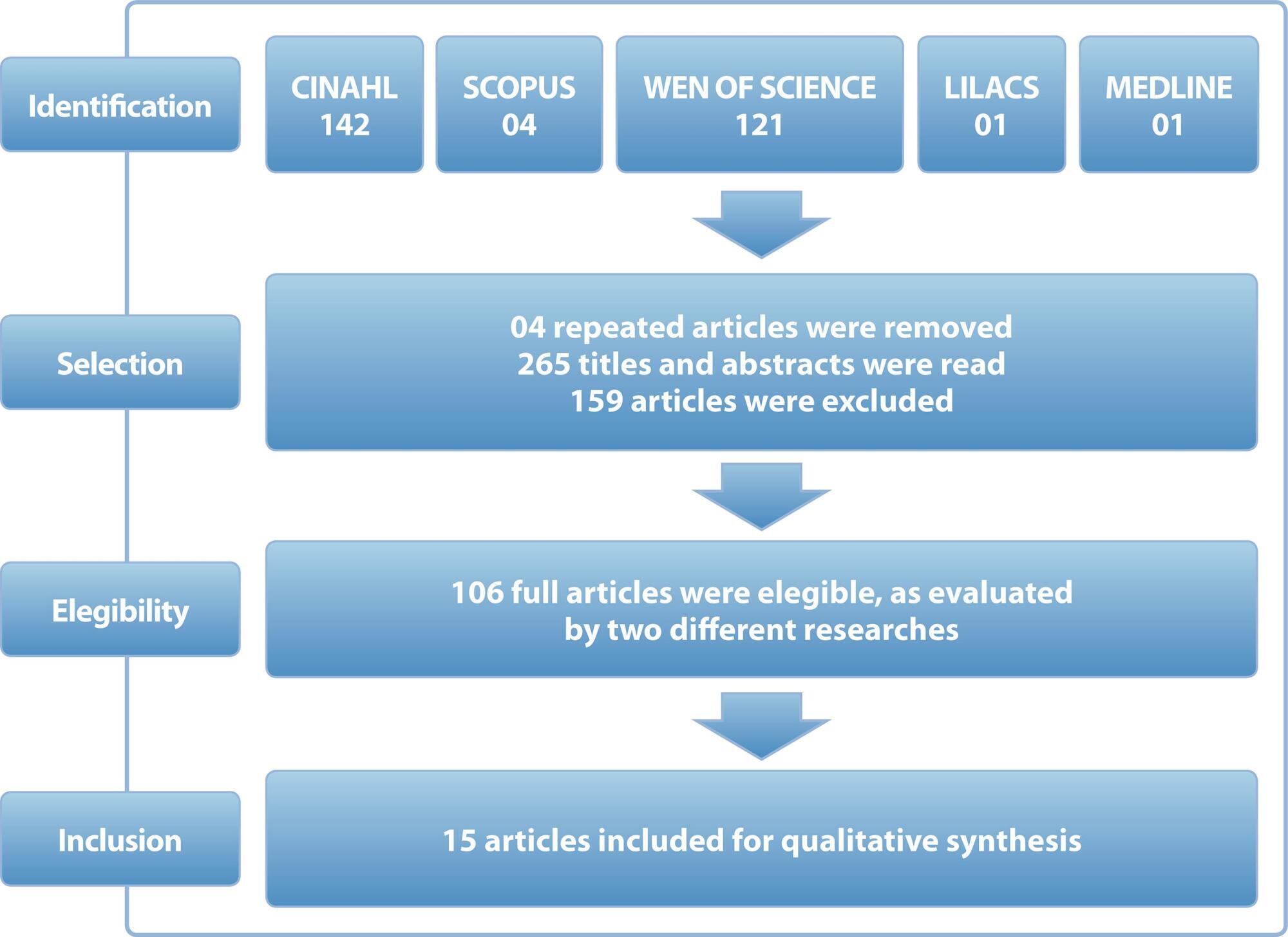
-
ORIGINAL ARTICLE11-10-2022
Effect of educational video on newborn care for the knowledge of pregnant and postpartum women and their families
Revista Brasileira de Enfermagem. 2022;75:e20201371
Abstract
ORIGINAL ARTICLEEffect of educational video on newborn care for the knowledge of pregnant and postpartum women and their families
Revista Brasileira de Enfermagem. 2022;75:e20201371
DOI 10.1590/0034-7167-2020-1371
Views0See moreABSTRACT
Objectives:
to evaluate the effect of educational video on newborn care to increase the knowledge of pregnant, postpartum, and family members.
Methods:
a quasi-experimental study, with pre-intervention and post-intervention evaluation with a single group. Fifty-eight pregnant, postpartum, and family members treated in basic health units and a hospital in Ceará, Brazil, participated. The study used the McNemar and binomial tests for the analysis.
Results:
after the intervention, there was an increase in the frequency of hits, from 70.82% to 92.97%. Most of the questions presented a significant increase of hits (p < 0.05) with an emphasis on sleeping position, drying of clothes, free demand for breastfeeding, and things to avoid (such as accessories in the sleeping place and talc in diaper change).
Conclusions:
the educational video was effective to participants in acquiring knowledge on the care of newborns and can assist in health education activities carried out by nurses.
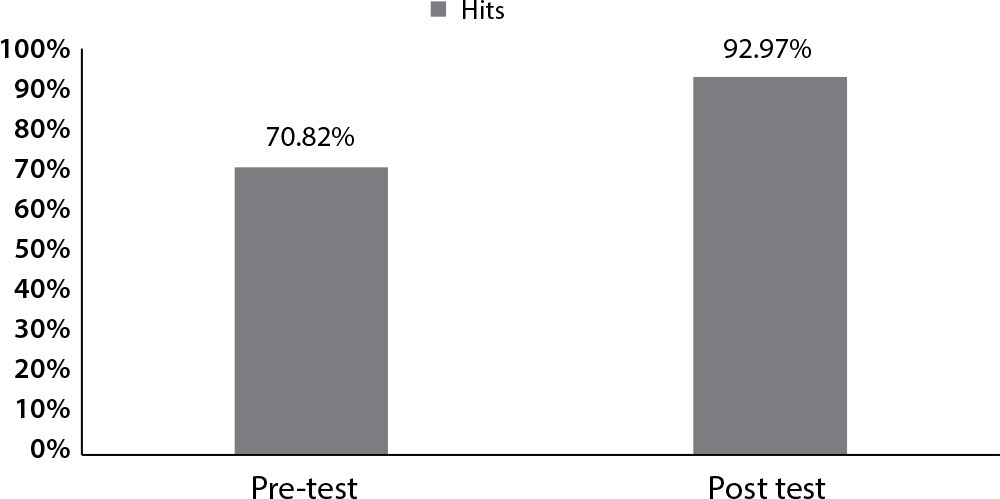
-
EDITORIAL08-01-2022
Monkeypox: between precision public health and stigma risk
Revista Brasileira de Enfermagem. 2022;75(5):e750501
Abstract
EDITORIALMonkeypox: between precision public health and stigma risk
Revista Brasileira de Enfermagem. 2022;75(5):e750501
DOI 10.1590/0034-7167.2022750501
Views0The World Health Organization (WHO) is on alert due to an unprecedented Monkeypox outbreak in non-endemic countries, such as Europe, which have been affected recently. Despite the low pandemic potential, the recent SARS-CoV-2 pandemic has contributed to heightened levels of public concern in the face of the threat of new global health emergencies().As of May […]See more -
ORIGINAL ARTICLE03-30-2020
Clinical simulation in teaching Pediatric Nursing: students’ perception
Revista Brasileira de Enfermagem. 2020;73(2):e20180720
Abstract
ORIGINAL ARTICLEClinical simulation in teaching Pediatric Nursing: students’ perception
Revista Brasileira de Enfermagem. 2020;73(2):e20180720
DOI 10.1590/0034-7167-2018-0720
Views0See moreABSTRACT
Objectives:
to comprehend the perception of undergraduate nursing students about learning to care for the child and family through clinical simulation.
Methods:
this is a qualitative research conducted with ten nursing students through semi-structured interviews. Data were analyzed through content analysis.
Results:
data were organized into two categories: “learning a new way to learn,” in which students describe their experiences during the simulation, and “learning a new way to care,” in which they reflect on learning through simulation.
Final considerations:
we believe that clinical simulation practice in teaching should be encouraged because of the benefits it can offer to the students, faculty, patients and their families. However, we recommend further studies to validate scenarios of child and family healthcare.
-
ORIGINAL ARTICLE11-02-2020
Transitional care from hospital to home for older people: implementation of best practices
Revista Brasileira de Enfermagem. 2020;73:e20200187
Abstract
ORIGINAL ARTICLETransitional care from hospital to home for older people: implementation of best practices
Revista Brasileira de Enfermagem. 2020;73:e20200187
DOI 10.1590/0034-7167-2020-0187
Views0See moreABSTRACT
Objective:
to assess the conformity of nursing care concerning best evidence in transitional care from hospital to home for older people.
Methods:
a project to implement best evidence based on the model proposed by the Joanna Briggs Institute in surgical clinic of a university hospital with older people, caregivers or family members, and nurses, between July and August 2019. Eight evidence-based criteria have been audited through interviews, medical records and computerized system, presented in percentages.
Results:
the highest non-compliance rate found in a baseline audit was absence of continued training on transitional care and hospital discharge plan. Identifying barriers to best practices included educational programs; afterwards, there was an improvement in compliance rates in all the criteria assessed.
Final considerations:
the criteria based on audited evidence showed an increase in compliance rates with the strategies implemented, contributing to improving transitional care for older people.

-
ORIGINAL ARTICLE10-18-2022
Methodological path to reach the degree of saturation in qualitative research: grounded theory
Revista Brasileira de Enfermagem. 2022;75(2):e20201379
Abstract
ORIGINAL ARTICLEMethodological path to reach the degree of saturation in qualitative research: grounded theory
Revista Brasileira de Enfermagem. 2022;75(2):e20201379
DOI 10.1590/0034-7167-2020-1379
Views0See moreABSTRACT
Objectives:
to achieve the degree of saturation in study that applied the grounded theory.
Methods:
qualitative research, carried out in four Family Health Units, between June 2018 and May 2019. The data from the interviews with 30 health professionals and non-participant observation were coded in the stages: open, axial and integration.
Results:
the degree of saturation was achieved by two conceptual models – theoretical saturation and inductive thematic. Theoretical saturation was considered: the development of conceptual codes and observation, in the collection and analysis of data, when they generated new categories/subcategories or only indicated increasing instances. For thematic inductive saturation, the use of new codes based on each interview stood out.
Final Considerations:
the visual layout for the number of codes, the theoretical scope of the concepts and the delimitation of the sample groups guided the identification of the degree of saturation for the development of the conceptual body that supported the substantive theory.
-
ORIGINAL ARTICLE10-21-2019
Practice challenges in patient safety
Revista Brasileira de Enfermagem. 2019;72(6):1504-1511
Abstract
ORIGINAL ARTICLEPractice challenges in patient safety
Revista Brasileira de Enfermagem. 2019;72(6):1504-1511
DOI 10.1590/0034-7167-2018-0441
Views0See moreABSTRACT
Objective:
to understand the professional practice challenges in reaching the goals and objectives of the National Patient Safety Program (Programa Nacional de Segurança do Paciente).
Method:
qualitative case study, based on the Comprehensive Sociology, carried out with 31 professionals from the Patient Safety Center (Núcleo de Segurança do Paciente) and the nursing team, working in a teaching hospital. Data collection took place between May and December 2015 through interviews, observation and documentary analysis. The analysis proceeded according to the prerogatives of the Content Analysis.
Results:
three categories emerged: the prescribed reality; material resources and their impact on care; and human resources related to the reality.
Final considerations:
challenges to safe professional practice are caused by inadequate physical structure, insufficient physical and human resources, but mainly invade the transition from the prescriptive reality scope.
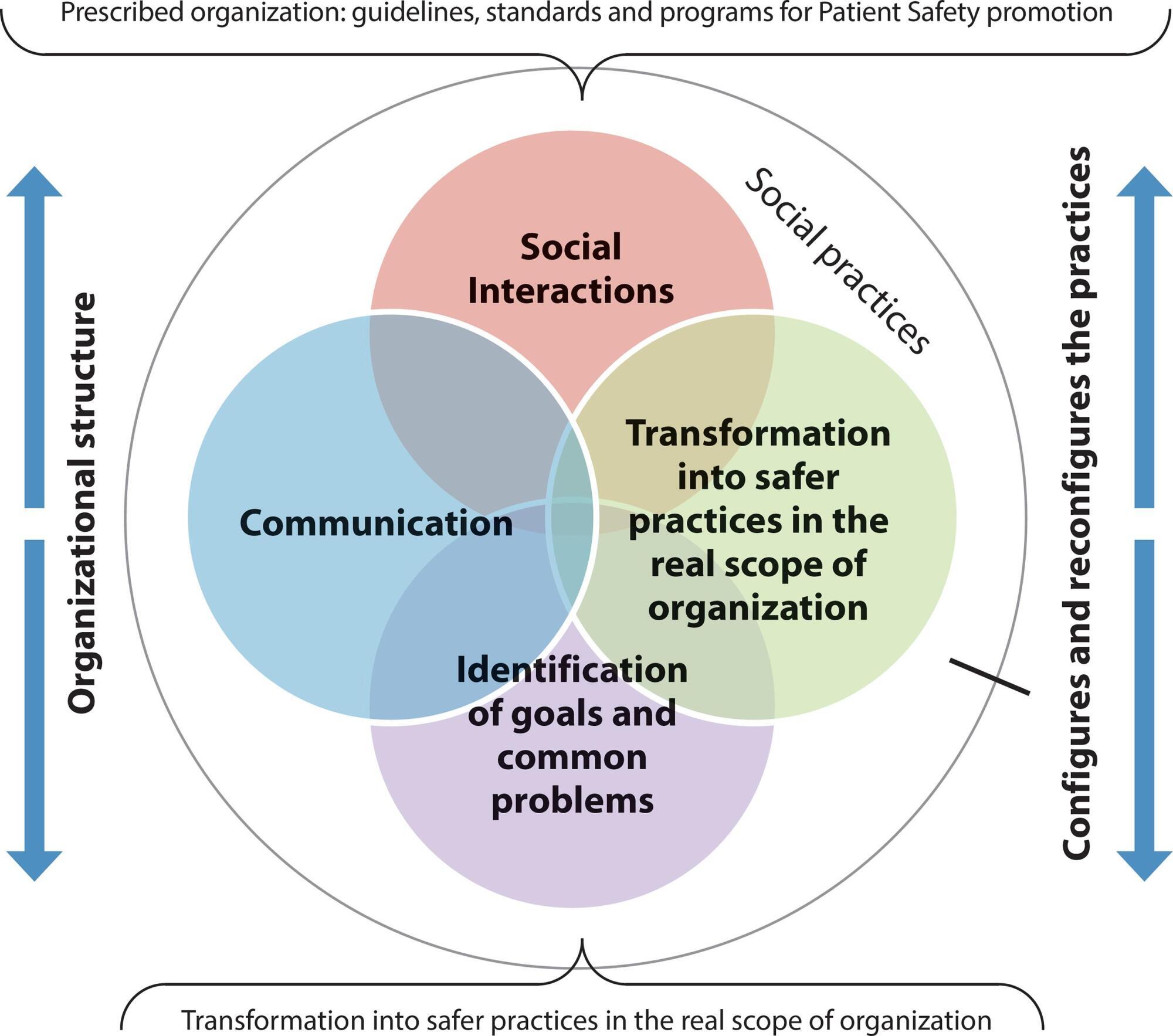
-
RESEARCH01-24-2017
Nurses in the labor market: professional insertion, competencies and skills
Revista Brasileira de Enfermagem. 2017;70(6):1220-1226
Abstract
RESEARCHNurses in the labor market: professional insertion, competencies and skills
Revista Brasileira de Enfermagem. 2017;70(6):1220-1226
DOI 10.1590/0034-7167-2016-0061
Views0See moreABSTRACT
Objective:
to characterize nurses graduated from the School of Nursing of the University of São Paulo, from 2006 to 2012; verify their entry, facilitating factors and difficulties of these graduates in the labor market and to consider their skills and competences in the world of work.
Method:
an exploratory, descriptive study with a qualitative approach.
Results:
out of 505 graduates, 172 (34.1%) participated in the research. Entry into the labor market was mainly via public hospital institutions, in the SE of Brazil, in the caregiving sectors. The greater part remained from one to two years in their first job. Most agreed that they were prepared to meet the health needs of the population. Furthermore, they had been encouraged to seek systematic and continuous improvement in a critical, reflexive and creative way, while combining technical-scientific knowledge and personal skills.
Conclusion:
the results show that the University of São Paulo has been preparing nurses for work in the labor market, in accordance with the provisions of the National Curricular Guidelines.
Search
Search in:
Nuvem de Tags
Aged (144) Atenção Primária à Saúde (239) COVID-19 (104) Cuidados de Enfermagem (269) Educação em Enfermagem (151) Educação em Saúde (139) Enfermagem (930) Estudos de Validação (131) Health Education (144) Idoso (208) Mental Health (149) Nursing (987) Nursing Care (306) Patient Safety (151) Primary Health Care (284) Qualidade de Vida (104) Quality of Life (106) Saúde Mental (145) Segurança do Paciente (150) Validation Studies (108)




